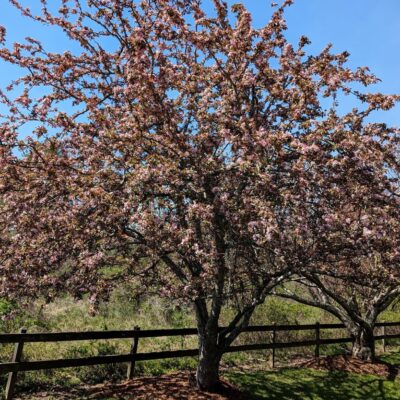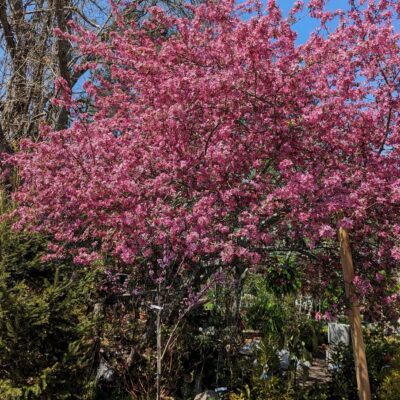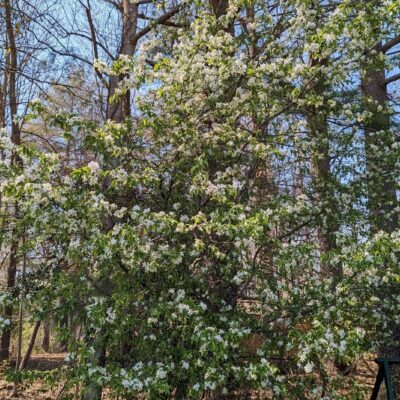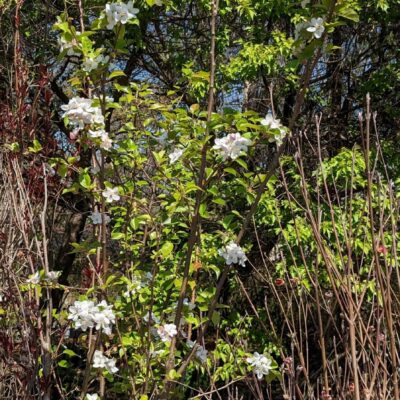Crabapples are in the genus Malus, which includes the domestic apple (Malus pumila), which had their origin in Kazakhstan. Apple trees grow in temperate regions the world over. Hendersonville, North Carolina is in the top ten apple growing regions in the U.S. As I am writing in the Blue Ridge, it seems fitting to feature an article on apples and crabapples that you can grow! I hope this blog is something that you can sink your teeth into!

Apples are in the rose family (Rosaceae). They are grown for their flowers, fruit, and fall color. They prefer full sun and well-drained soil. They attract wildlife including rabbits, deer and birds! This may not be as great an advantage as it sounds, but there are methods to protect your trees. When planting an apple tree, a tree guard fitted around its base will help to protect it from rabbit and mice in the winter months. This is especially important to young (small caliper) trees. A perimeter fence will help to protect the young tree from deer browse.

Two Crabs of Note
The Prairie fire crabapple produces a profusion of pink-magenta flowers and deep reddish-purple foliage. The tiny fruit is very attractive to birds. Plant as an ornamental.

There are numerous cultivars of crabapples that you can plant as ornamentals. Of note is Malus coronaria ‘Charlottae’ which produces fragrant, pale pink semi-double flowers in spring.
Picking Apples (for planting)
There are bushels and bushels of apple varieties, so how do you decide on what to plant? Here are a few suggestions on points to consider before making a purchase.
- Consider the USDA zone that you live in, the varietals’ disease resistance, bloom and harvest times, and use. Apple trees are as a group, hardy. They will do well in zones as cold a 3 and some, in the very warm zone 11!
- Apples are susceptible to a host of diseases, an unfortunate trait of the rose family. These include: fire blight, a bacterial infection (caused by Erwinia amylovora), fungal diseases including apple scab (Venturia inaequalis), cedar apple rust (Gymnosporangium juniperi-virginiae), powdery mildew (Podosphaera leucotricha) and a number of fruit rots.
- If your area is prone to spring frosts, consider late blooming varietals. In addition, consider the length of your growing season and pick apple varietals that will do best in your area. If for example, you have a long growing season, consider mid and late maturing cultivars to stagger your harvest.
Before I discourage you entirely from planting an apple tree (or two!), consider selecting apples that have good to excellent disease resistance that are adapted to your growing zone. To improve cross pollination, plant two varietals that bloom at the same time.
A final consideration is whether or not to consider grafted trees. Grafted trees have very definite advantages over standard trees. The most obvious is that grafting on a dwarfing rootstock helps to control the ultimate size of your trees, which make managing them, easier. Consider semi-dwarf or dwarf trees, depending on your space requirements.
So why grow apples? They can be used for eating, baking and for making sweet and hard ciders!

Examples of heirloom varieties with excellent disease resistance include:
- Arkansas Black
- Bramley Seedling
- Crown Prince Rudolph
- Holstein
- Kidd’s Orange Red
- Melrose
- Orleans Reinette
- Pitmaston Pineapple
- Roxbury Russet
Example of heirloom varieties with good disease resistance include:
- Brown Snout
- Campfield
- Cinnamon Spice
- Ellis Bitter
- Ernst Bosch
- Fearns Pippin
- Foxwhelp
- Golden Reinette
- Harrison
- Ingrid Marie
- James Grieve
- Jefferis
- Kandil Sinap
- Kerry Irish Pippin
- Mother Apple
- Northern Spy
- Opalescent
- Red Astrachan
- Red vein Crab
- Ribston Pippin
- Siberian Crab
- Winekist
You will note that there is quite a list of apples you can grow! You will also note that Macs, Red Delicious and Honeycrisp are nowhere to be found. Not that you cannot grow these, but they will take more effort in their care not to say nothing of their spray schedules! The heirlooms in the list do need preventative spray applications, but I think these lend themselves to sustainable cultivation. They can be grown well using copper sprays, azadirachtin, and insecticidal soaps, but more on that later.
Highlighted Tree Features
Bramley Seedling
A tart, green apple that is good for fresh eating, pies and cider. This cultivar does not require a pollinator, so if you only have room for one, consider Bramley Seedling.
Cinnamon Spice
A sweet, red apple with notes of cinnamon, for fresh eating, cider and baking. This variety requires a different variety with the same (mid-season) bloom period.
Ernst Bosch
A pale yellow-green apple with pineapple notes, good for eating fresh, cider and baking. Blooms mid-season.
Foxwhelp
An ancient English cider apple with notes of butterscotch and pear. Blooms mid-season.
Harrison
An heirloom variety originating in New Jersey for fresh or fermented cider or for eating. Blooms mid-season. Traditionally planted with Campfield.
Holstein
Originated in Germany, cultivated for fresh eating, pies and cider. An abundant producer, stores well. Blooms mid-season.
Kidd’s Orange Red
Apples are pink-red and yellow, balanced sugars, acids and aromas, excellent for fresh eating, cider and baking. Blooms mid-season.
Melrose
The state apple tree of Ohio. Sweet, firm and juicy, a long keeper, grow this apple for fresh eating, baking and cider. Blooms mid-season.
Red Vein Crabapple
Fruit is small, oblong with red flesh! Used for sauce and cider, it imparts a red tint! Blooms mid-season.
Roxbury Russet
An heirloom dating to the 1600’s in the Boston neighborhood of Roxbury! Excellent old cider apple tree with loads of sugar. Blooms late.
Join us next week for a look at some problems plants can face.
~ Signing off for now, Joe


